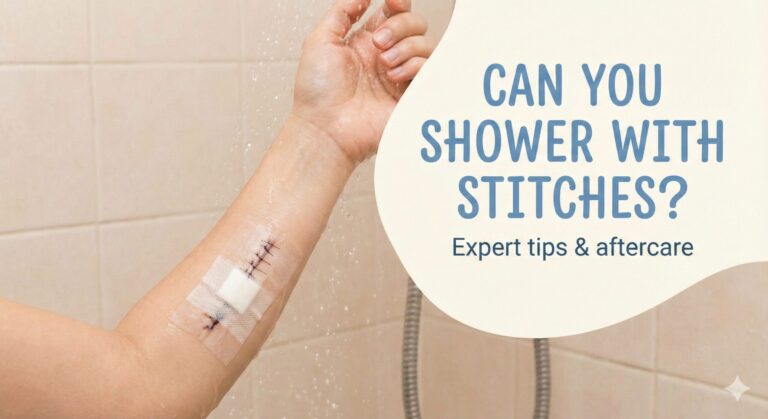Cold or Hot Shower for Fever? The Doctor-Approved Answer
⚕️
Medical Disclaimer: This article is for informational purposes only and does not constitute medical advice. High fevers (over 103°F/39.4°C) or fevers lasting more than 3 days require medical attention. If you experience difficulty breathing, confusion, or severe pain, seek emergency care.
You are shivering under three blankets, yet your forehead is burning up. Your body aches, and you feel gross. The instinct to hop in the shower is strong, but you pause at the handle. Should you freeze the fever out with a cold shock? Or should you “sweat it out” with steam?
The debate of cold vs. hot shower for fever is one of the most common home remedy questions. Getting it wrong can actually make your condition worse. We have analyzed the science of thermoregulation to give you the definitive answer. Whether you are dealing with a flu, a reaction to new tattoo inflammation, or just a seasonal bug, here is how to bathe safely.
The Answer: Neither!
You should take a LUKEWARM (Tepid) SHOWER.
Extreme cold causes shivering (which raises body temp), while extreme heat increases the risk of fainting and dehydration.
1. Why Extremes Are Dangerous
To understand why Goldilocks was right (not too hot, not too cold), we need to look at how your body regulates heat.
❄️ Cold Shower
The Risk: Shivering.
Cold water shocks the body. Your muscles contract rapidly (shivering) to generate warmth. This actually raises your internal core temperature, defeating the purpose.
🔥 Hot Shower
The Risk: Overheating.
You are already hot. Adding external heat prevents your body from cooling down. It also causes vasodilation, leading to dizziness and nausea.
💧 Lukewarm
The Solution.
Water slightly cooler than your body temp (85°F – 90°F) allows heat to evaporate from your skin gently without triggering the shivering reflex.
According to VeryWellHealth, a lukewarm bath or sponge bath is a safe, effective method to help lower a fever, especially if medication hasn’t kicked in yet.
2. Step-by-Step: The Safe Fever Shower Protocol
Showering while weak and dizzy requires extra precautions. Don’t just jump in. Follow this protocol to ensure safety.
Step 1: Preparation is Key
Before you even turn the water on, ensure the bathroom is safe. Fevers cause weakness.
• Place a non-slip mat down.
• Have a sturdy shower chair ready. Even if you aren’t elderly, sitting down prevents falls if you get lightheaded.
• Ensure you have a squeegee to dry the floor immediately after so you don’t slip.
Step 2: Set the Temperature
Aim for “Tepid.” This should feel slightly cool to the touch but not cold. If your valve is broken and you can’t get a consistent temp, check our guide on fixing shower faucets before risking it. You don’t want a sudden burst of scalding water.
Step 3: Keep it Short
Stay in for 5-10 minutes max. The goal is to cool the skin, not to deep clean. If you stay too long, the steam might make you feel faint. Using a handheld shower wand allows you to target your body while keeping your head out of the spray.
Step 4: Dry Immediately
Do not let yourself get chilled when you step out. Dry off quickly and dress in light, breathable clothing. If you start shivering, cover up until it passes.
3. Too Weak to Shower? Try These Alternatives
Sometimes, standing in the shower is just too much effort. If you are exhausted, listen to your body. There are benefits to skipping the shower when you are ill—conserving energy is one of them.
- The Sponge Bath: Fill a basin with lukewarm water. Use a washcloth to wipe your face, armpits, and groin. As the water evaporates, it cools your blood.
- Cold Compresses: Place a cool (not frozen) damp cloth on your forehead, back of the neck, and wrists.
- Rest: Sometimes sleep is the best medicine. Read about how temperature timing affects sleep to optimize your rest.
Essential Recovery & Safety Gear
When you are sick, you want comfort and safety. Here are the top-rated tools to help you manage a fever at home.
Medical Grade Shower Chair
Safety First. Fevers cause vertigo. Do not risk a fall on hard tile. This chair allows you to sit under the lukewarm water safely. Essential for every household’s emergency kit.
Check Price on Amazon
Touchless Digital Thermometer
Monitor the Heat. Stop guessing. Know exactly when your fever spikes or breaks. This is crucial for deciding when to shower or when to call a doctor.
Check Price on Amazon
SparkPod Handheld Spray
Controlled Cooling. A fixed head forces you to stand. A handheld wand lets you sit and direct the cool water exactly where you need it (neck, back) without freezing your face.
Check Price on Amazon
Frequently Asked Questions
Does “sweating it out” work?
No. Attempting to “sweat out” a fever by taking a hot shower or burying yourself in blankets can dangerously raise your body temperature. It can lead to heat exhaustion and dehydration.
Can I wash my hair when I have a fever?
Yes, but wet hair can make you feel colder afterward, triggering shivering. If you wash it, dry it immediately with a towel or hair dryer on a warm setting.
Why do I feel colder after a shower with a fever?
Evaporation causes cooling. While this is good for lowering a fever, if it happens too fast, you will shiver. Keep the room warm by closing the shower doors or curtain until you are fully dried off.
Should I shower if I’m dizzy?
Absolutely not unless you have a chair. Dizziness is a precursor to fainting. If you feel dizzy, do a sponge bath in bed instead. See: Why do I get dizzy in the shower?
Conclusion
When fighting a fever, your goal is comfort and gentle cooling, not shock therapy. Cold showers are too harsh, and hot showers are dangerous. Stick to the middle path: a short, lukewarm shower while seated.
Listen to your body. If you are too weak to stand, skip the shower and rest. Your hygiene can wait; your recovery cannot. Stay hydrated, stay safe, and let the fever break naturally.
Disclaimer: As an Amazon Associate, ShowerBlog earns from qualifying purchases.







